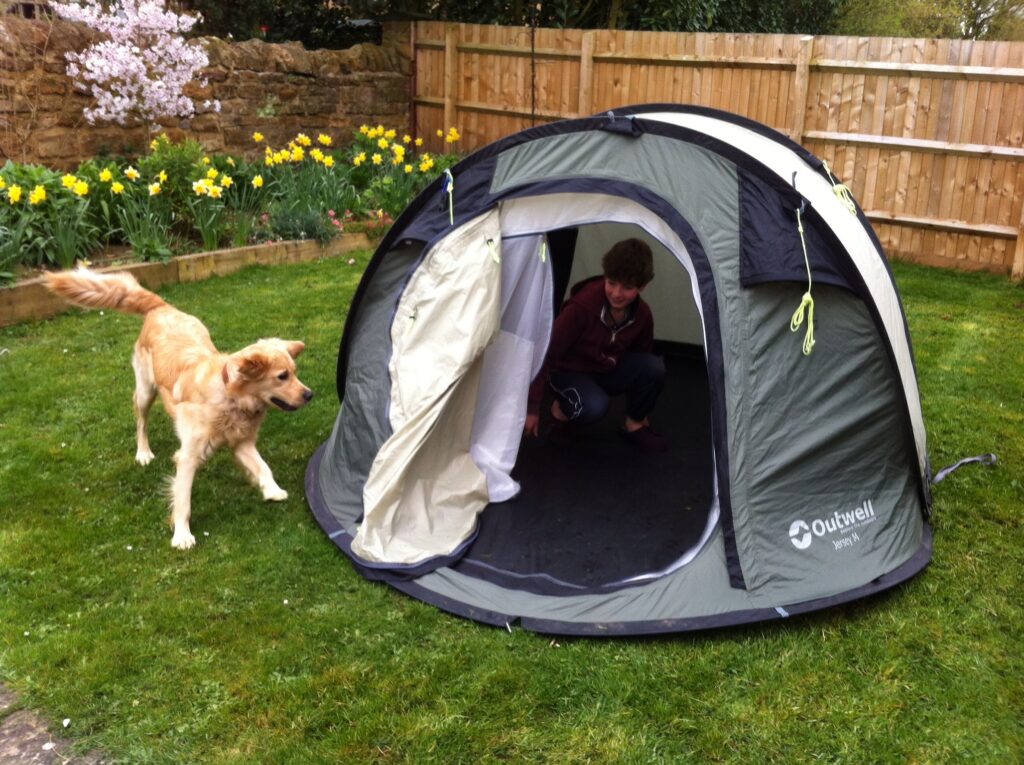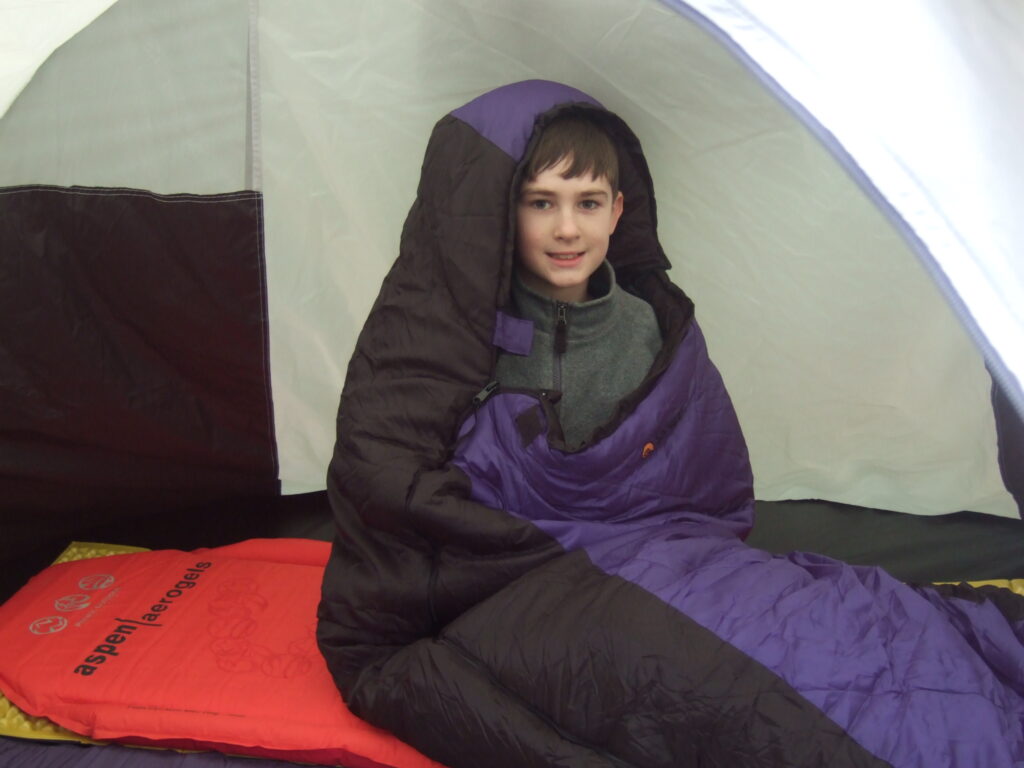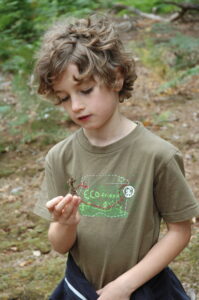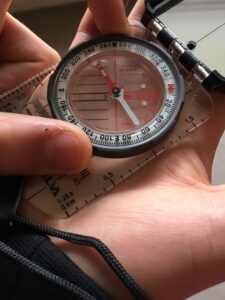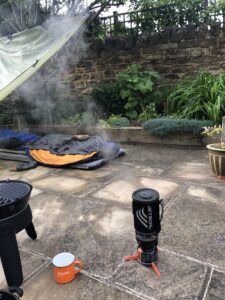Guest post: By Simon McGrath, the author of Camping with Kids and former Editor-in-Chief of Camping & Caravanning magazine
I’m passionate about the great outdoors and all the many health benefits, both mental and physical, that goes with it. And I’ve loved sharing that passion with my own family through our many camping adventures.
Camping in the garden, or using the lounge or bedroom at home, is a fantastic way to start any adventures. It’s also great fun and gives you the opportunity to teach and learn new skills.
In the past I’ve set up a hammock tent in a friend’s garden only to discover I had pitched it over a path frequently used by a badger at night! I’ve camped in my conservatory when my (then) young sons had their first garden camp out alone because my wife wanted someone to be nearby (that was a cold night for me but less so for my wife who was snugly tucked up in our bed). And more recently I built my own ‘bivvy’ in the garden during lockdown so that I could stare at the stars above me throughout the night.
Here are my top ten tips for the Youth Adventure Trust’s Camp Out week…
1. Pitch-in together: Remember the tent in the garden or lounge isn’t just a place to sleep in that night. You can get the imaginations of young minds going by involving them in the creation of your campsite. As a youngster I used to enjoy turning the cushions on the sofa into castles. Tents in the garden can also be great places to play (watch you don’t trip on the guylines), while putting them up in the first place is a great activity for all family members to do together.
2. Make food fun. Camping is a great way to enjoy meal times together as a family. Youngsters can be fussy eaters but when you take away the formalities of the dining room table, they can be much more in their element. Remember, it’s okay to eat with the plate on your lap, or to tuck in with your fingers (provided they’re clean). And camp cooking often means taking a more simplistic approach. So think skewers and wraps. Put food on a stick or inside a wrap and even the fussiest of little eaters suddenly plough through their dinner.
3. Can you create a rainbow? It’s fun to learn about the natural world around you and you can create your own rainbow in the garden on a sunny day. You’ll need a hose with the nozzle set to a fine mist spray (or hold your thumb over the end of the pipe to create one) and aim it in the direction of your shadow. You may need to adjust the angle of the spray but a rainbow should appear in front of you. The children can then draw the rainbow they’ve just created with lots of bright colours – just don’t forget the pot of gold at the end!
4. Light up the tent with a lantern: If you have a bottle of water and a headtorch you can make your own camping lantern. Simply fill up the bottle with water and then stretch the strap of the headtorch around the bottle several times until it’s secure. Then point the light in towards the water and switch it on. The water will magnify the light to illuminate your tent. If your headtorch has a red light function, that can add an atmospheric glow too. And the handy thing is the lantern can double as a night-time drink (just remember to recycle the plastic water bottle afterwards). Torches are also fun for staging shadow pup shows on the side of the tent when it gets dark. Or why not learn some Morse Code using the torch: –. — — -.. -. .. –. …. – (in other words, “good night”).
5. Enjoy a spot of star gazing: If you camp on a nice clear night, don’t forget to do a bit of star-gazing, which is especially good for getting young minds thinking creatively. Can the kids spot a shooting star from the garden or lounge window? And is there really a man on the moon? If you’re in the garden, take your roll mat out of the tent when it gets dark, lay it on the floor and use it to insulate yourself from the ground when you stare up at the night sky. And you won’t get a stiff neck too. Why not get them to draw what they saw the next day.
6. Where’s the wildlife: Camping is a great way to introduce children and young people to the great outdoors. And even the wildlife in the garden at night can be a new experience for kids. Why not compare the different wildlife you see and hear both during the day and again at night once it’s dark. Was that the snuffle of a hedgehog I just heard outside the tent…?
7. Get crafty: The garden is full of things to use for art and crafts. You could collect sticks and leaves to create a collage, or look for a really interesting-shaped stone to paint and turn into a creature like a ladybird. Or why not glamp up your tent with some home-made bunting? They’re great things to remember your adventures by and they’re good for ‘show and tell’ at school too.
8. Make a map: Teach the kids map-making skills using your home campsite as a location. Get them to pretend they are a bird looking down on the site, and start drawing the map from the top left corner. Identify north and mark it on the map, together with symbols (using a key to remember those symbols). Think scale and add a splash of colour. If the children are really interested in navigation, you can turn your watch into a compass. Simply point the hour hand of an analogue watch at the sun, keeping it flat. Look where 12 o’clock is on the watch face and imagine there is a bisecting line between the hour hand and the 12. That line is pointing south, so north is in the opposite direction on your watch. You can then work out the other ‘cardinal’ directions of east and west.
9. Learn some beautiful birdsong: The chances are the birdsong of the dawn chorus will wake you up early if you’re camping in the garden. So don’t roll over and go back to sleep – enjoy it instead. See if you can identify different types of birdsong, even if you don’t know what the specific bird is. The RSPB has a very handy birdsong identifier here: https://www.rspb.org.uk/birds-and-wildlife/bird-songs/what-bird-is-that/
10. And don’t forget… I’ve learned the hard way over the years of what not to forget when camping. Thankfully, this is all the easier since you’re at home but remember your pillow, a bottle of water in case someone needs a drink during the night, a torch (smart phones usually have these features too), and that teddy also needs to come along. Oh, and don’t forget to pack your own sense of fun and adventure too!
- For more information about getting started with camping, visit The Camping and Caravanning Club’s new to camping section here: www.newtocamping.co.uk


